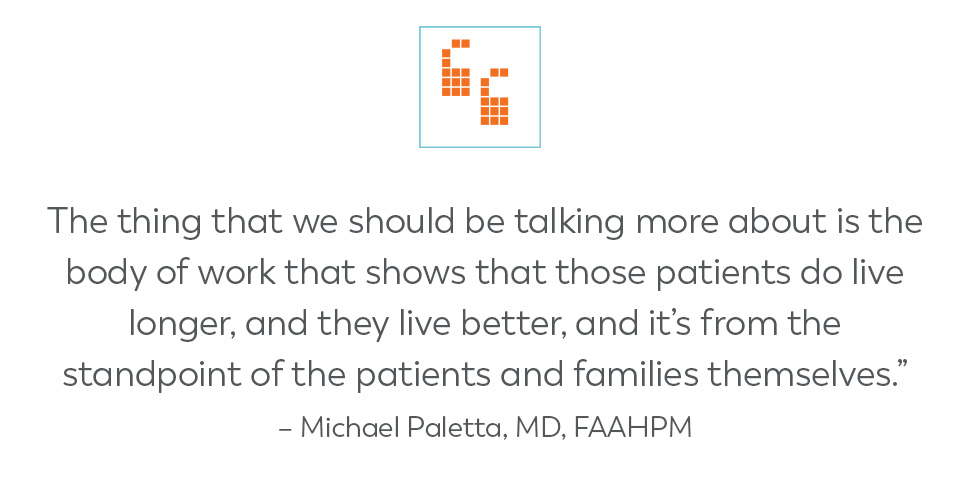Lack of Clear Communication About Hospice Leads to Late Referrals
Hospice has been an option for end-of-life care in our country for more than 45 years. While it hasn’t been available in every state for as many years, it’s not new. Yet, so many Americans don’t have a complete understanding of hospice. So often when we’re speaking with families who have experienced hospice for a loved one, they say they delayed contacting hospice initially for a number of reasons. Some of the responses we hear are, “I thought it meant we were giving up” or “I thought hospice was only for the last days of life.”
Is it fear that prevents families, or patients themselves, from contacting a hospice provider sooner? Is it our hope that maybe there’s another treatment option to consider? Do doctors fear they’re failing their patients if they suggest it’s time for comfort care over a curative approach? So many misconceptions about end-of-life care get in the way for people to be able to learn about or experience the full scope of care and support that is available to patients suffering a life-limiting illness and their families. On the problem with misconceptions, author Deb Caletti said, “We can get so wrapped up in our own misconceptions that we miss the simple beauty of the truth.”
Because of the misconceptions or fear, it’s disheartening to know how many people don’t experience the full value of hospice care. This includes my family. My mother was being treated for ovarian cancer that spread to her liver and right lung. While she was in the hospital for a complication, she received excellent care from their palliative care team. After a few weeks in the hospital, my mom was discharged to a long-term care hospital to regain her strength so she could resume cancer treatment. Unfortunately, within a few days, we realized the cancer and the complication took more of a toll on her than we knew. We transitioned her to hospice care … for five days.
According to the NHPCO Facts and Figures on Hospice Care in America, 53.8% of hospice patients receive care for 30 days or less. Of that percentage, 27% receive care between one and seven days. In such a short span of time, patients and their families don’t have the opportunity to realize the full scope of physical, emotional and spiritual support.
Hospice can be a difficult topic to discuss for physicians and patients/family caregivers. Both groups of people have perceptions about hospice care that lead to late referrals and short lengths of stay.

Physician perspectives on hospice that lead to late referrals
In many cases, physicians don’t recommend hospice or delay referring patients until shortly before death. One of the reasons for late referrals cited most often is that doctors are trained to cure illness and disease. Recommending hospice may be perceived as a failure on their part. Another often cited reason is physicians’ discomfort with having difficult conversations about end-of-life care with patients.
On the issue of low hospice utilization, Dr. R. Sean Morrison, chair of the department of geriatrics and palliative medicine at New York’s Icahn School of Medicine, said, “I would say that this is a communication issue, not a need issue.” He went on to say, “Millions of Americans could benefit a great deal from hospice. And people have actually paid for this benefit all of their lives, so they should access it as much as they can. And not just at the very end, but as early as possible, when they can still gain many months of social support, practical support, and expert care and service.”
Dr. Gail Gazelle, assistant professor of medicine at Harvard Medical School and associate scientist at Brigham and Women’s Hospital, echoed the sentiment that late referrals are a result of a communication issue. She said, “The issue is caused by miscommunication between doctors, patients and caregivers. Efforts need to be made to better educate physicians on the merits of hospice and how to broach the topic of end-of-life care with patients and family members.”

Family caregiver perspectives on hospice that lead to short LOS
Transcend Strategy Group has conducted surveys with more than 20,000 family healthcare decision makers across the country. We’ve found the majority of people associate hospice with imminent death, often causing patients and families to avoid seeking hospice services or even learn more about them. Often, families fear recommending hospice will be interpreted as giving up.
Once families experience hospice care for a loved one, they get it. In conversations with families, we almost always hear that they wished they would have known about hospice earlier – or called a hospice provider sooner. With firsthand experience, they understand how their loved one and their family would have benefitted from the expertise in care and support in the last months of life.
Education is key to earlier referrals
Educating physicians as well as patients and family caregivers on the truths of hospice care is key to sparking earlier referrals. The information needs of these audiences vary. It’s important to speak to the aspects of hospice care that address their needs.
In one of our most popular podcast episodes, Michael Paletta, MD, FAAHPM, chief medical officer and senior vice president for Hospice of Michigan, underscored the importance of educating physicians with facts and data. “The thing that we should be talking more about is the body of work that shows that those patients do live longer, and they live better, and it’s from the standpoint of the patients and families themselves.”

Patients and family caregivers have different needs when it comes to learning about hospice. Rather than a fact-based approach that speaks to physicians, families are coming to hospice from an emotional standpoint. Their loved one has a life-limiting illness. They may be struggling as a primary caregiver. Providers need to communicate they are not only experts in caring for patients near the end of life, they are also experts in helping family caregivers be more competent and confident in taking care of their loved ones at home, and they are experts in providing emotional and spiritual support at a difficult time.
Case study on achieving earlier referrals
With shifting demographics and the need to accelerate outreach to underserved populations in their market, Chautauqua Hospice & Palliative Care (CHPC), based in Lakewood, NY, came to Transcend to educate their community about the benefits of hospice and the reasons to call sooner. The objectives were clear – to educate the community on the truths about hospice to reduce the fears and stigmas associated with end-of-life care and encourage people to contact CHPC directly to discuss what care and support are available and appropriate at any stage of a disease. To ignite earlier referrals, Transcend created a multimedia education campaign that personalized the benefits of hospice care through compelling family stories. Clear, consistent messaging proved successful in growing census 13% and average length of stay 26%.
To learn more about how Transcend can help you clearly communicate the value you provide to patients and their families to spark earlier referrals and grow your agency, contact Emily Zarecki at emily@transcend-strategy.com.










